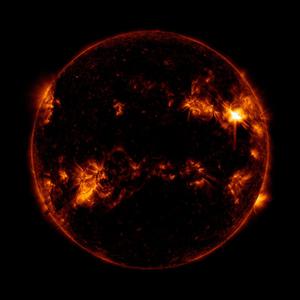Glossarbegriffe: Stellare Aktivität
Description: "Aktivität" ist ein Sammelbegriff für die verschiedenen Auswirkungen, die Magnetfelder auf Sterne haben. Sterne mit starken Magnetfeldern haben mehr Sternflecken auf ihrer Oberfläche. Stellare Magnetfelder sind wahrscheinlich auch die Wärmequelle für die Korona eines Sterns, sodass Sterne mit starken Magnetfeldern mehr Röntgen- und Ultraviolettstrahlung aus ihrer Korona aufweisen. Die Aktivität lässt sich auch im Spektrum des Sterns erkennen, insbesondere in der Emission der H-alpha-Linie (einer Spektrallinie von angeregtem Wasserstoff). Zusammengenommen quantifizieren diese Effekte grob die "Aktivität" eines Sterns. Massereiche Sterne (mit dem Spektraltyp O, B und frühes A) haben in der Regel eine geringe Aktivität. Die Aktivität nimmt bei Sternen mit geringerer Masse zu und erreicht ihren Höhepunkt bei Roten Zwergen (M-Zwergen). Junge Sterne sind aktiver als alte Sterne. Die Sonne folgt einem Aktivitätszyklus von 11 Jahren, der sich in einer unterschiedlichen Anzahl von Sonnenflecken niederschlägt (Sonnenfleckenzyklus).
Zugehörige Glossarbegriffe:
- B-Stern
- Korona
- Wasserstoff
- Roter Zwerg
- Sonnenfleckenzyklus
- Spektralklasse
- Sonnenfleck
- Sonnenfleckenzyklus
- Ultraviolett
- M-Stern
- Magnetfeld
- O-Stern
- Röntgenstrahlung
See this term in other languages
Term and definition status: The original definition of this term in English have been approved by a research astronomer and a teacher The translation of this term and its definition is still awaiting approval
The OAE Multilingual Glossary is a project of the IAU Office of Astronomy for Education (OAE) in collaboration with the IAU Office of Astronomy Outreach (OAO). The terms and definitions were chosen, written and reviewed by a collective effort from the OAE, the OAE Centers and Nodes, the OAE National Astronomy Education Coordinators (NAECs) and other volunteers. You can find a full list of credits here. All glossary terms and their definitions are released under a Creative Commons CC BY-4.0 license and should be credited to "IAU OAE".
If you notice a factual or translation error in this glossary term or definition then please get in touch.
Zugehörige Medien
Sunspots
Bildnachweis: NASA/SDO/HMI credit link
License: PD Public Domain icons
Solar flare
Bildnachweis: NASA/SDO credit link
License: PD Public Domain icons










